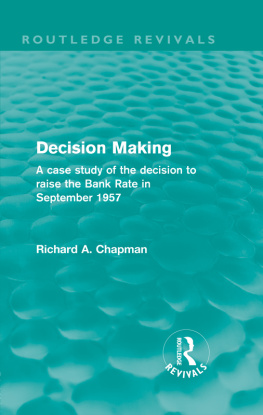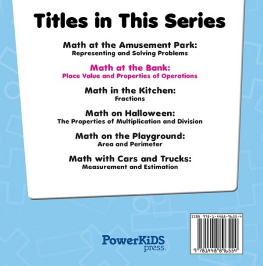Routledge Revivals
Decision Making
Originally published in 1968, Richard Chapmans pioneering work illuminates the process of decision making by analysis of a particular example: the decision to raise the Bank Rate in September, 1957. The legal responsibility for a decision may be easy to pinpoint; in this case the Court of Directors of the Bank of England bear this but six weeks of negotiation separate their formal statement from the Chancellor of the Exchequers advice to the Treasury to consider effecting a measure of deflation in the economy. These six weeks of consultation between the Bank and the Treasury proceeding in the pattern of a formal dance are analysed and a necessary by-product of this case-study is a closer understanding of how the Treasury and the Bank of England work together. These details are derived mainly from the evidence, and deductions from it, presented to the Bank Rate Tribunal and the Radcliffe Committee on the Working of the Monetary System.
Professor Chapman gives his particular findings about decision making a wider application still by forming reasoned hypotheses and informed generalisations about public administration in Britain.
Mr Chapmans case study is a pioneering work. He looks at how and why the decision was reached and gives an exciting reconstruction of how the decision was takenThe Times
Decision Making
A case study of the decision to raise the Bank Rate in September 1957
Richard A. Chapman
First published in 1968
by Routledge & Kegan Paul Ltd
This edition first published in 2011 by Routledge
2 Park Square, Milton Park, Abingdon, Oxon, OX14 4RN
Simultaneously published in the USA and Canada
by Routledge
711 Third Avenue, New York, NY 10017
Routledge is an imprint of the Taylor & Francis Group, an informa business
1968 Richard A. Chapman
All rights reserved. No part of this book may be reprinted or reproduced or utilised in any form or by any electronic, mechanical, or other means, now known or hereafter invented, including photocopying and recording, or in any information storage or retrieval system, without permission in writing from the publishers.
Publishers Note
The publisher has gone to great lengths to ensure the quality of this reprint but points out that some imperfections in the original copies may be apparent.
Disclaimer
The publisher has made every effort to trace copyright holders and welcomes correspondence from those they have been unable to contact.
A Library of Congress record exists under ISBN: 0710063024
ISBN 13: 978-0-415-50817-9 (hbk)
ISBN 13: 978-0-203-12569-4 (ebk)
Decision Making
A case study of the decision to raise the Bank Rate in September 1957
by Richard A. Chapman
Reader in Politics
University of Durham
First published 1968
by Routledge & Kegan Paul Ltd
Broadway House, 68-74 Carter Lane
London, EC4V 5EL
Reprinted 1971
Printed in Great Britain
by Unwin Brothers Limited
The Gresham Press, Old Woking, Surrey
Richard A. Chapman 1968
No part of this book may be reproduced
in any form without permission from
the publisher, except for the quotation
of brief passage in criticism
ISBN 0 7100 7226 0(P)
ISBN 0 7100 6302 4(c)
General Editors Introduction
This series of monographs is designed primarily to meet the needs of students of government, politics, or political science in Universities and other institutions providing courses leading to degrees. Each volume aims to provide a brief general introduction indicating the significance of its topic, e.g. executives, parties, pressure groups, etc., and then a longer case study relevant to the general topic. First year students will thus be introduced to the kind of detailed work on which all generalisations must be based, while more mature students will have an opportunity to become acquainted with recent original research in a variety of fields. The series will eventually provide a comprehensive coverage of most aspects of political science in a more interesting and fundamental manner than in the large volume which often fails to compensate by breadth what it inevitably lacks in depth.
There are few case studies of how administrators go about their work, at least on this side of the Atlantic, and this monograph is one of the pioneering studies in this field. The volume is concerned with an analysis of the decision to raise the Bank Rate in September, 1957. It presents a considerable amount of evidence shedding light on how the Bank of England and the Treasury work together. These details are derived mainly from the evidence, and deductions from it, presented to the Bank Rate Tribunal and the Radcliffe Committee on the Working of the Monetary System. In his discussion and analysis of decision-making in this particular context, Mr Chapman uses his material as the basis of hypotheses about public administration in general.
An article on this subject by Mr Chapman appeared in Public Administration, Summer 1965, Vol. 43 and we are grateful to the Editor for permission to make use of this.
H.V.W.
Contents
Introduction
An executive decision is a moment in a process. The growth of a decision, the accumulation of authority, not the final step, is what we need most to study.
(Follett, 1949, 1.)
Students of public administration in Britain need to consider how administrators really work. It is not very valuable to know merely what institutions are, we must also know what they do. Professor W. A. Robson has said, few studies have appeared showing how government departments really do their workI can say this after having read all the volumes of The New Whitehall Series (Public Administration, 1961). And the Editor of Public Law, after recalling Robsons remarks, has commented that there are no books on administrative law which approach the subject through the administrative process, by showing the way in which decisions are taken and the political and legal forces which have shaped those decisions (Public Law, 1961).
However, it is easier to notice this sort of gap in the study of public administration than to fill it. This is partly because it is difficult to make any detailed study of how government departments work without willing co-operation from the departments concerned. It is also partly because the descriptive method favoured by most British writers on public administration has not been adequate for this purpose. While factual description may illustrate some aspects of how administrators work, this alone may not be very penetrating. We need to be able to evaluate the facts in order to decide which are the most important; we need also to examine the motives of the administrators and the forces which influence their actions. In order to discover how government departments really do their work theory and facts have to be considered togethera hypothesis is formulated, the facts examined and the hypothesis may be modified and retested against further facts. If the facts are presented on their own the result may be formal and unreal; it may be argued, for example, that the lack of theoretical discussion is the main weakness of both











